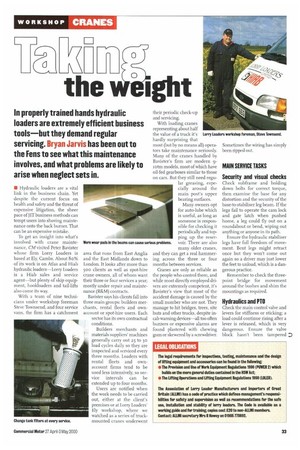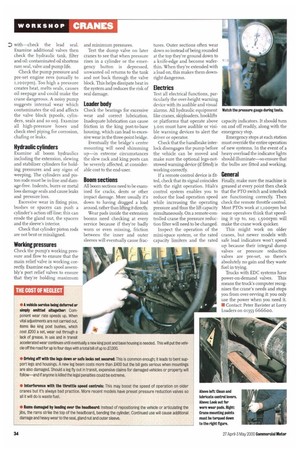In properly trained hands hydraulic loaders are extremely efficient business
Page 35

Page 36

If you've noticed an error in this article please click here to report it so we can fix it.
tools—but they demand regular servicing. Bryan Jarvis has been out to the Fens to see what this maintenance involves, and what problems are likely to arise when neglect sets in.
• Hydraulic loaders are a vital link in the business chain. Yet despite the current focus on health and safety and the threat of expensive litigation, the sheer pace ofjIT business methods can tempt users into shoving maintenance onto the back burner. That can be an expensive mistake.
To get an insight into what's involved with crane maintenance, CM visited Peter Bavister whose firm Lorry Loaders is based at Ely, Cambs. About 8o% of its work is on Atlas and Hiab hydraulic loaders—Lorry Loaders is a Hiab sales and service agent—but plenty of skip equipment, hookloaders and tail-lifts also come its way.
With a team of nine technicians under workshop foreman Steve Townsend, and four service vans, the firm has a catchment area that runs from East Anglia and the East Midlands down to London. It looks after more than 500 clients as well as spot-hire crane owners, all of whom want their three or four services a year; mostly under repair and maintenance (R&M) contracts.
Bavister says his clients fall into three main groups: builders merchants, rental fleets and ownaccount or spot-hire users. Each sector has its own contractual conditions.
Builders merchants and materials suppliers' machines generally carry out 25 to 30 load cycles daily so they are inspected and serviced every three months. Loaders with rental fleets and ownaccount firms tend to be used less intensively, so service intervals can be extended up to four months.
Users are notified when the work needs to be carried out, either at the client's premises or at Lorry Loaders' Ely workshop, where we watched as a series of truckmounted cranes underwent
their periodic check-up and servicing.
With loading cranes representing about half the value of a truck it's hardly surprising that most (but by no means all) operators take maintenance seriously. Many of the cranes handled by Bavister's firm are modern 9iotrn models, most of which have oil-fed gearboxes similar to those on cars. But they still need regular greasing, especially around the main post's upper bearing surfaces.
Many owners opt for auto-lube which is useful, as long as someone is responsible for checking it periodically and topping up the reservoir. There are also many older cranes, and they can get a real hammering across the three or four months between services.
Cranes are only as reliable as the people who control them, and while most directly employed drivers are extremely competent, it's Bavister's view that most of the accident damage is caused by the small number who are not. They manage to hit bridges, trees, site huts and other trucks, despite in
cab warning devices all too often buzzers or expensive alarms are found plastered with chewing gum or skewered by a screwdriver.
Sometimes the wiring has simply been ripped out.
MAIN SERVICE TASKS Security and visual checks
Check subframe and holding down bolts for correct torque, then examine the base for any distortion and the security of the base-to-stabiliser leg beam. If the legs fail to operate the cam lock and gate latch when pushed home, a leg could fly out on a roundabout or bend, wiping out anything or anyone in its path.
Ensure the hydraulic stabiliser legs have full freedom of movement. Bent legs might retract once but they won't come out again so a driver may just lower the feet to unload, which is a dangerous practice.
Remember to check the threepoint bridge for movement around the bushes and shim the mountings as required.
Hydraulics and PTO
Check the main control valve and levers for stiffness or sticking; a load could continue rising after a lever is released, which is very dangerous. Ensure the valve block hasn't been tampered with—check the lead seal. Examine additional valves then check the hydraulic tank, filter and oil: contaminated oil shortens ram seal, valve and pump life.
Check the pump pressure and pre-set engine revs (usually to Lroorpm). Too high a pressure creates heat, melts seals, causes oil seepage and could make the crane dangerous. A noisy pump suggests internal wear which contaminates the oil and affects the valve block (spools, cylinders, seals and so on). Examine all high-pressure hoses and check steel piping for corrosion, chafing or leaks.
Hydraulic cylinders
Examine all boom hydraulics including the extension, slewing and stabiliser cylinders for holding pressures and any signs of weeping. The cylinders and piston rods must be in-line and damage-free. Indents, burrs or metal loss damage seals and cause leaks and pressure loss.
Excessive wear in fixing pins, bushes or spacers can push a cylinder's action off-line; this can erode the gland nut, the spacers and the sleeve's interior.
Check that cylinder piston rods are not bent or misaligned.
Working pressures
Check the pump's working pressure and flow to ensure that the main relief valve is working correctly. Examine each spool assembly's port relief valves to ensure that they're holding maximum and minimum pressures.
Test the dump valve on later cranes to see that when pressure rises in a cylinder or the emergency button is depressed, unwanted oil returns to the tank and not back through the valve block. This helps dissipate heat in the system and reduces the risk of seal damage.
Loader body
Check the bearings for excessive wear and correct lubrication. Inadequate lubrication can cause friction in the king post-to-base housing, which can lead to excessive wear in the three-point bridge.
Eventually the bridge's centre mounting will need shimming up—in extreme circumstances the slew rack and king posts can be severely affected, at considerable cost to the end-user.
Boom sections
All boom sections need to be examined for cracks, dents or other impact damage. More usually it's down to having dragged a load around, rather than lifting it directly.
Wear pads inside the extension booms need checking at every service because if they're badly worn or even missing, friction between the inner and outer sleeves will eventually cause frac
tures. Outer sections often wear down so instead of being rounded at the top they're ground down to a knife-edge and become waferthin. When they're extended with a load on, this makes them downright dangerous.
Electrics
Test all electrical functions, particularly the over-height warning device with its audible and visual alarms. All hydraulic equipment like cranes, skiploaclers, hooklifts or platforms that operate above 3.om must have audible or visible warning devices to alert the driver or operator.
Check that the handbrake interlock disengages the pump before the vehicle can be moved and make sure the optional legs-notstowed warning device (if fitted) is working correctly.
If a remote control device is fitted, check that its signal coincides with the right operation. Hiab's control system enables you to reduce the load operation speed while increasing the operating pressure and thus the lift capacity simultaneously. On a remote-controlled crane the pressure reduction filter will need to be changed.
Inspect the operation of the mini-space system, or the rated capacity limiters and the rated capacity indicators. It should turn on and off readily, along with the emergency stop.
Emergency stops at each station must override the entire operation of new systems. In the event of a heavy overload the indicator lights should illuminate—so ensure that the bulbs are fitted and working.
General
Finally, make sure the machine is greased at every point then check that the PTO switch and interlock are functioning correctly. Then check the remote throttle control. Most PTOs work at 'Jo orprn but some operators think that speeding it up to, say, 1,500rpm will make the crane work quicker. This might work on older cranes, but newer models with safe load indicators won't speed up because their integral dump valves or pressure reduction valves are pre-set, so there's absolutely no gain and they waste fuel in trying.
Trucks with EDC systems have power-on-demand valves. This means the truck's computer recognises the crane's needs and stops you from over-revving it: you only use the power when you need it.
• Contact: Peter Bavister at Lorry Loaders on 05353 666600.








































































































